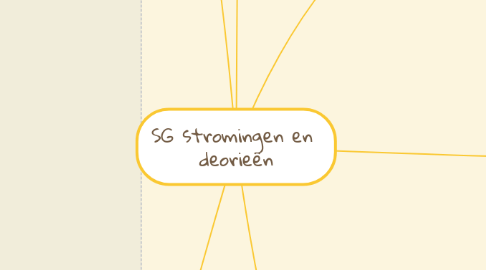
1. Postmodernisme na 1980
1.1. Waardering (eerste) Chicago School (1892-1930): brug klassieke en moderne sociale wetenschap, interdisciplinariteit en onderzoek op meerdere schaalniveau's linken
1.1.1. W.I. Thomas
1.1.1.1. "5/4 Wishes, The Unadjusted Girl with cases and standpoint for behavior analysis" (1923)
1.1.1.1.1. Maslow pyramide/hierarchy of needs (1943): "A theory of human motivation, psychological review"
1.1.1.2. Theorema (1923): "If men define things as real, they are real in their consequences"
1.1.1.2.1. Robert Merton: Self-fulfilling prophecy
1.1.2. Charles Cooley
1.1.2.1. The looking glass Self -> Sociale media
1.1.2.2. "Sympathetic introspection" : observeren van eigen kinderen in familieverband om de menselijke natuur te bestuderen -> Nature vs Nurture
1.1.3. Robert Park
1.1.3.1. "The City": stad als een systeem waar microstudies zoals "the Hobo", "The Gang" en"The Jack Roller" in gesynthetiseerd wordt
1.1.3.1.1. Urban/social ecology: evolutie stad zoals een ecologisch proces (darwinistisch). "The city is a product of nature"
1.1.3.1.2. "Concentrische zone theorie": stadsmodel voor stedelijke groeiprocessen (Burgess) in 5 zones: Central business district, transitional, working class, residential, commuter zones
1.1.4. George H. Mead
1.2. "Critical mapping"
1.2.1. Monmonier: "How to lie with maps"
1.2.2. Kaarten zijn niet neutraal en puur objectief
1.2.2.1. Kaarten dragen bij tot de sociale productie van ruimte
1.2.2.2. Kaarten zijn sociaal en politiek geconstrueerd: als wensbeeld van de realiteit (socio-eco en politieke context van belang!)
1.2.2.2.1. Gerry-mandering
1.2.2.3. "Maps encompass ideologies"
2. Armoede en segregatie
2.1. Functionele verklaring/analyse (Herbert Gans: zie functionalisme)
2.2. Structurele verklaring
2.2.1. The occupational structure
2.2.2. The property structure
2.2.3. The authority structure
2.2.4. correlatie ongelijkheid en gezondheid/ sociale problemen
2.3. Culturele verklaring
2.3.1. Lewis: culture of poverty
2.3.2. Murray: "welfare dependency"
2.3.3. Blaming the victim en sociaal darwinisme
2.3.4. Onderscheid (un)deserving poor en parallele welvaartstaat
2.4. Wat/wie is arm(oede)
2.4.1. Absolute armoede
2.4.2. Relatieve armoede
2.4.3. Sociale uitsluiting
2.4.3.1. Multi-dimensionaliteit/non-participatie
2.4.3.2. Nadruk op proces
2.4.3.3. Sociale relaties/individuen binnen hun sociale context
2.4.3.4. Schuyt: niet enkel over bezit (armoede), ook over "en-/dis-abling" + 5 dimensies
2.4.3.4.1. Gering economisch rendement/bijdrage
2.4.3.4.2. Morele negatieve stigmatisering en "othering"
2.4.3.4.3. Ruimtelijke segregatie
2.4.3.4.4. Lage sociale weerbaarheid
2.4.3.4.5. Zwakke rechtspositie
2.5. Segregatie
2.5.1. 5 drijvende factoren ruimtelijke spreiding/concentratie (migrantengroepen)
2.5.1.1. Taal
2.5.1.2. Regionaal/cultureel
2.5.1.3. Religieuze
2.5.1.4. Oude migranten onthalen nieuwe
2.5.1.5. Institutionele beperking: discriminatie
2.5.1.5.1. Impliciet woningmarkt (paired testing)
2.5.1.5.2. "Red lining"
2.5.1.5.3. Gedwongen (vb getto's)
2.5.2. Ruimtelijke (residentiële) spreiding bevolkingsgroepen op basis van welke criteria?
2.5.3. Concentratie VS segregatie
2.5.3.1. Concentratie: hoeveel mensen van een groep leven in eenzelfde subgebied => Locatiequotiënt
2.5.3.2. Segregatie: hoeveel mensen van een groep moeten van gebied veranderen om dezelfde relatieve spreiding te vertonen als een referentiegroep => dissimilariteitsindex
2.5.3.2.1. Kan ook op andere ruimtelijke eenheden: bv Gini-index
3. Humanistische geografie na 1970
3.1. Hägerstrands tijd-ruimte geografie
3.1.1. "Innovation diffusion as a spatial process" (1950-1967)
3.1.2. Tijd-ruimte paden: "what about people in regional science?"(1970)
3.2. "Mental mapping"
3.2.1. Lynch: "The image of the city" (1960)
3.2.1.1. Paden
3.2.1.2. Grenzen
3.2.1.3. Landmarks
3.2.1.4. Knopen
3.2.1.5. Districten
4. Positivisme/kwantitatieve revolutie 1945-1970
4.1. Christaller: centrale plaatsen theorie 1933
4.1.1. Sassen 1991: "The Global City"
4.2. Von Thünen: model agrarisch landgebruik/grondrente (1783-1850)
4.2.1. Wet van Hotelling 1929: "principe van minimale differentiatie"
4.2.2. Alonso: stadsmodel 1946 (Burgess+Von Thünen)
4.3. Functionalisme: sociale fenomenen hebben altijd functies om een sociaal systeem te onderhouden/veranderen
4.3.1. Robert K. Merton
4.3.1.1. Manifeste en latente functies
4.3.1.2. Sociale systemen veranderen voortdurend op de lange termijn door dysfuncties en alternatieven
4.3.2. Herbert Gans: functionele analyse van armoede ("the uses/positive functions of poverty"-1971)
4.3.2.1. Economische functies
4.3.2.2. Sociaal-culturele functies
4.3.2.3. Sociaal-status functies
4.3.2.4. Sociaal-politieke functies
5. Radicale geografie na 1970 (historisch materialisme Marx)
5.1. Opkomst van de stad en verstedelijking
5.1.1. Klassieke sociologische definitie stad= Wirth: "Urbanism as a way of life" (1938: Chicago School)
5.1.1.1. Grootte
5.1.1.2. Heterogeniteit
5.1.1.3. Dichtheid
5.1.2. Harvey: "Sociaal Justice and the City" (1973)
5.1.2.1. Stad= "ruimtelijke concentratie van maatschappelijk surplus"
5.1.2.2. Studie verstedelijking= "studie circulatie maatschappelijk surplus"
5.2. Productiewijzen en ruimtelijke organisatie: Ideaaltypische samenlevingsvormen
5.2.1. Bobek (1962): "The main stages in socio-economic evolution from a geographical point of view"
5.2.2. 5-ledige classificatie Dodgshon (1987): "The European Past: social evolution and spatial order"
5.2.2.1. Zwerfgroepen
5.2.2.2. Egalitaire stammen
5.2.2.3. Hoofdijen
5.2.2.4. Vorstendommen
5.2.2.5. Moderne staten

